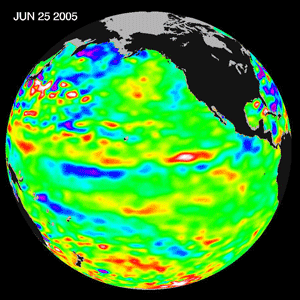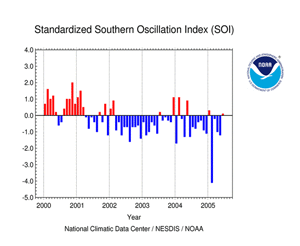NEUTRAL PHASE OF ENSO REMAINS - SLIGHTLY WARM
SSTs PERSIST IN WESTERN AND CENTRAL
PACIFIC
|
|
Sea-Surface
Temperatures (SSTs) and
Mixed-Layer Conditions: SSTs decreased across the eastern equatorial Pacific Ocean and along the South American coast in June, as reflected in the Niño 1+2 region, although the monthly averaged SST anomalies increased slightly in the central and western parts of the Pacific basin. Above average temperature anomalies, which have persisted over the past six months in the mixed-layer decreased during June, as below average water temperatures expanded along the equatorial cold-tongue in the eastern Pacific region. For the month, the SST anomaly in both the Niño 3.4 and Niño 4 Index regions in the central and western equatorial Pacific Ocean decreased to +0.44°C (+0.79°F) above the mean (map of Niño regions). For the most recent ocean surface temperature conditions, please see the loop of satellite-derived weekly SST anomalies for June 2005. Above average SST anomalies persisted throughout the latter-half of 2004 and through the first half of 2005 in the western and central equatorial Pacific basin, which can be seen in the data from NCDC's Extended Reconstructed Sea Surface Temperature dataset (ERSST version 2). At the end of June, the 3-month running mean of the Niño 3.4 Index remained below +0.5°C. (NOTE: A running 3-month mean SST anomaly above +0.5°C in the Niño 3.4 region is one indicator that an El Niño is occurring. For the official NOAA classification scheme, please see NOAA's El Niño/La Niña Index Definition and see the CPC ENSO Diagnostic Discussion for NOAA's latest official assessment of ENSO conditions.) |
|
|
Equatorial
Zonal Winds (U-Component Winds) and Sea-Level
Topography: The easterly trade winds were near-normal across the eastern equatorial Pacific basin during June. In the western equatorial Pacific basin near the date line, westerly wind anomalies developed during the latter half of the month (see the June zonal wind loop). Several high frequency fluctuations in the trade winds also occurred in the central tropical Pacific during June, as the strength of the easterly flow varied considerably along the equatorial zone. Satellite altimetry of ocean surface topography from the NASA/JPL Jason-1 satellite over the Pacific basin and global oceans is shown to the left. The June 25th overpass of the Jason-1 satellite shows that there were no large-scale sea-level anomalies present across the equatorial Pacific basin near the end of this past month. |
|
|
Outgoing
Longwave Radiation (OLR): The map to the left shows the spatial pattern of global OLR (in W m-2) observed by satellite during June. Only a few small areas with positive OLR anomalies were measured in the western tropical Pacific during the past month. In addition, negative OLR anomalies were observed just north of the equator in the central Pacific. A significantly different pattern is evident in the most recent 3-month averaged OLR anomalies, with large areas of negative OLR anomalies west of the dateline and along the South Pacific Convergence Zone (SPCZ). Enhanced tropical convection was also observed during the April-June period in the central Pacific basin immediately north of the equator along the Inter-Tropical Convergence Zone (ITCZ). The monthly-averaged OLR Index was near-neutral in June, with a value of 0.3 averaged across an area centered over the dateline in the western Pacific (between 160° E and 160° W). The OLR Index has shifted sign several times over the past 9 months, reflecting the lack of persistence of El Niño conditions in the atmosphere since the latest warm event developed in mid-2004. Note that high frequency variability in OLR is typically associated with the Madden-Julian Oscillation (MJO) (MJO related convective activity propagates west to east in the near-equatorial region from the Indian Ocean into the Pacific Ocean approximately every 30-60 days). The latest MJO activity can be seen in CPC's graphs of Daily MJO Indices. |
| Southern
Oscillation Index (SOI): The standardized SOI was near-average in June, with a monthly averaged index value of 0.1. Similar to the OLR Index, the SOI has shown unusual behavior during the relatively weak 2004-2005 El Niño event. For example, during the latter-half of 2004 the monthly SOI fluctuated several times between a near-zero value (indicating near-neutral conditions) and a more negative index (indicating El Niño conditions), although 2004 ended with seven consecutive negative monthly values. The most recent trend of the SOI over the past few months has been toward a near-zero value. This reflects the transition to an ENSO neutral state in the atmosphere, as a near-average mean sea-level pressure (MSLP) pattern was observed in June across the tropical Pacific basin. Therefore, despite the persistence of anomalously warm SST anomalies in the Niño 3.4 and 4 Index regions during June, the majority of oceanic and atmospheric indices suggests that the current state of ENSO remains in a neutral phase. |
Additional Links
- ENSO Monitoring
- NOAA El Niño / La Niña Index Definition
- NOAA's Pacific Marine Environmental Laboratory (PMEL):
- NOAA's Climate Prediction Center (CPC):
- NOAA's Physical Science Laboratory
- NASA/JPL Ocean Surface Topography from Space
- Australian Bureau of Meteorology (BoM) Climate Driver Update
- IRI - International Research Institute
 NOAA's National Centers for Environmental Information
NOAA's National Centers for Environmental Information







